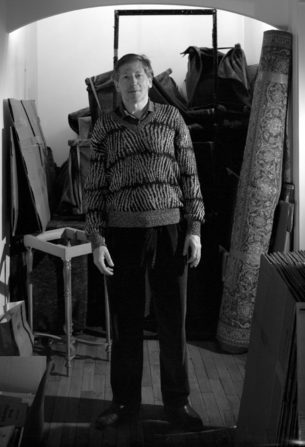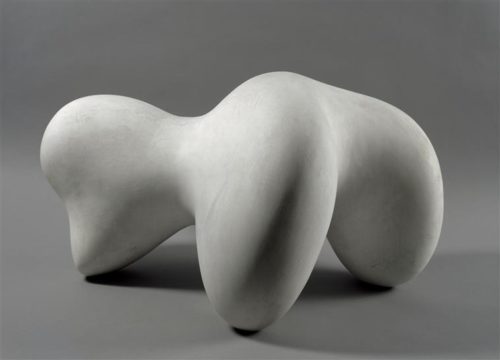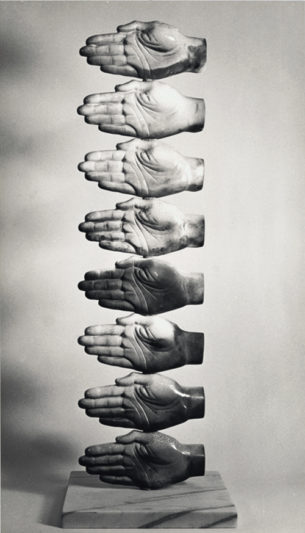
Christine Baumgartner
“And now bad Christians run about at the time of Carnival with masks and jests and other superstitions. Similarly witches use these revelries of the devil for their
own advantage, and work their spells about the time of the New Year.”
Heinrich Krämer and Jakob Sprenger, Malleus Maleficarum
“When you see something that is technically sweet, you go ahead and do it and you argue
about what to do about it only after you have had your technical success.
That is the way it was with the atomic bomb.”
Robert Oppenheimer
This year saw the death of Denis Johnson and Sam Shepard. I knew Sam personally, and Denis only very slightly. Both shared something that I think has gone out of Western literature and theatre. And it is what a friend described as the embrace of something that most western bourgeoisie fear — it is that neurotic fear and cowardice when faced with one’s own limitations. The mass production of ironic narratives of absolute literalness has bled into almost everything creative. Even into architecture. You find ghosts in Shakespeare, but in Shepard, too, and in another sense such things are present in Pinter, as well. In fact this anti instrumental is also closely related to the uncanny. But to something else, as well.

Eric de Mare, photography (Sussex, 1956).
It was the 72nd anniversary of the bombing of Hiroshima and Nagasaki. Kai Erickson wrote of this…
“The attacks on Hiroshima and Nagasaki were not “combat” in any of the ways that word is normally used. Nor were they primarily attempts to destroy military targets, for the two cities had been chosen not despite but because they had a high density of civilian housing. Whether the intended audience was Russian or Japanese or a combination of both, then the attacks were to be a show, a display, a demonstration. The question is: What kind of mood does a fundamentally decent people have to be in, what kind of moral arrangements must it make, before it is willing to annihilate as many as a quarter of a million human beings for the sake of making a point. . . .”
Cruelty has existed for, it seems, all time. But something different happened with the Atomic bomb. Consider also that since this atrocity a good many countries went into accelerated production of nuclear weapons. The fear I write about in writers and artists is linked in subterranean psychic ways with what happened at Hiroshima. A calculus of cruelty was realized after that, the greatest instrumental event in western logic. This was science as a death machine.

Nicholas Alan Cope, photography.
“In the demonic world, the mask did similar work. It helped transform women into witches
—Ben Jonson’s, for example, were ‘vizarded, and masqu’d’’ —all the while suggesting
metamorphosis by enchantment, as well as symbolizing the central categories of demonic
immorality; ambiguity, inconstancy, deceit, and illusion. Satan, said an Englishman in 1681,
‘walks in Masquerade’”
Stuart Clark
There is a link in discussions of literalness and instrumental thinking with technique and mastery. Richard Sennett has a book out, volume one of a planned three volumes, titled The Craftsman.It is interesting that on the cover is a photograph of a man’s hands. For this is the received image of craft (a gendered image). He quotes Aristotle…“We consider that the architects in every profession are more estimable and know more and are wiser than the artisans, because they know the reasons of the things which are done.” This is a curious remark, and perhaps one that would not have been made a century earlier.

Andre Gelpke, photography. (Carnival, Dusseldorf 1982).
“The history (the prehistory-what came before) of writing in Mesopotamia begins with a millennial artistic tradition: paintings on the sides of clay vases and engravings on the stone seals in common use throughout the region. Artists were not only accustomed to projecting and concretely fixing images, to composing small tableaux intended, I won’t say to explain, but at least to suggest something in the realm of feelings rather than that of clear vision; but they acquired mastery over drawing, learning to plan out and sketch things in a few strokes: the big-bellied profile of a vase was enough to suggest that vessel, a stem with four shoots to portray the head of a grain plant. Writing was born the day when someone (who? when? under what circumstances?-we’ll never have the answers to these questions) understood that by systematically using a given number of such sketches in a design that was uniform enough to be recognizable everywhere, one could, like artists, not only give birth to an emotion, evoke a state of mind, but also transmit a message in plain language. The most ancient documents employing this writing, small clay tablets covered with these pictograms and dating, according to archeologists, from around 3200, indeed offer us a thousand different such sketches, all clearly traced, easy to distinguish from each other, and easy to recognize. This was no longer the fantasy and freedom of artists: it was by all evidence a fixed system.”
Juan Botero
Writing, of course, changed everything in terms of civilizational time. There is little record of oral societies for obvious reasons. The early writing of Mesopotamia was largely a language of accounting. It was the tool of trades people.

Helen Torr (1927).
There is a fascinating small book, “Cunning intelligence in Greek culture and Society”, by Marcel Detienne and Jean Pierre Vernant. It focuses on what the authors feel is a neglected area of classical studies on ancient Greece; the study of metis. There is no simple definition but it includes cunning and dexterity, resourcefulness and guile — but most it is the mental category of the craftsman. It entails adaptable cunning and wiley intelligence. And unlike logic, there are no systematic treatises on the topic. For this was something seen as very fluid and even furtive. Forethought was part of it, opportunism was also a part of it. Doctors were gifted with it, but so were fisherman. It was also seen to be most important in situations of ambiguity and moral complexity, transient and unavailable to systematic study. It was the skill of the disconcerting, and the unmeasurable. It was also at work in illusion and sleights of hand. It was the intelligence of the shadows.
Plato, one senses, was ambivalent on this topic. For it came too close to guessing and was not involved in the construction of *the truth*. In the pantheon of the Gods, this quality was carefully parsed. Zeus had the most, but also used it, perhaps, the least. Kronos and Prometheus both possessed it. The German philologist Wilomowitz defined it merely as ‘poetic memory’. Fpr he knew no other way to define it. Detienne and Vernant note that metis is crucial in Homer. Especially in the ‘Games’ section of The Illiad. For the man with this quality, perhaps counter intuitively, is not a man of impulse, but a man of patience. Yet when the time is determined, sensed, to be right, he, or she, will *pounce* (their word). Today one will hear great athletes described as having physical intelligence. Or even muscle memory. These are closely related, but not the same. In Zen, the nearly cliche phrase (at this point) is ‘the solution will emerge’. This is also related, but the difference in these cases has to do with the hidden shadowy aspect of metis. And this brings me back to witches and demons and ghosts. And to the misshapen trajectory of science as one finds it in the West today.

Latifah Echakhch
In ancient Greece *Kairos* was an important idea. One translation is opportunity. And here, the closeness to guessing and chance is seen. And why it made Plato nervous. Thucydides mentions knowing the *hidden* advantages and disadvantages of any given situation. And it was Odysseus who best personified the man of metis. But this was not ever a completely good thing. In Homer the use of opportunism is rightly criticized. Antilochus must make amends for his questionable tactics in winning the horse race. The Gods were never at peace with this category of thought, or of feeling.
And it interesting that contemporary theatre has such a hard time portraying Attic tragedy or Shakespearean tragedy. Putting aside the more obvious problems performing tragedy, there remains under layers of ritualistic learning and the elusive mental categories such as metis.

Sumerian Cuneiform –
Akkadian clay tablet,1900–1600 BC
Marcel Detienne, in the remarkable book The Garden of Adonis, chronicles the history of spices in antiquity. “Whatever their form and context, all these accounts appear to be constructed upon the opposition between two groups of complementary concepts: on the one hand the cold, the wet, the principle of corruption, putrid smells and remoteness from the fire of the sun; on the other the hot, the dry, the principle of incorruptibility, fragrant smells, and proximity to the heavenly fire. The dividing line between these two groups depends on the sun since the degrees and methods of ‘cooking’ are governed by its proximity or remoteness. Indeed, the relationships between all the different natural products, from wild grass to perfumed substances and including fruits and cultivated plants, can only be defined in these terms of concoction or cooking.”
It is ironic, or perhaps not, that the earliest writing on fragrance focuses on the Arabian peninsula and what is now Yemen. Frankincense and myrrh, and cassia and cinnamon, are all native to that region. At least that was the belief of the writers of Attic Greece. In fact Cassia was Chinese, or Indian. But the relevance here is in a kind of belief in astronomical divination, and in the development of secret knowledge.

Felix Labisse
“Throughout the Greek tradition, the vulture, like the eagle, is a bird from the heights: it builds its nest on inaccessible cliffs; no man can reach its lair nor discover its young. Herodorus of Heraclea, the author of a Heracles story written in the fifth century B.C. drew from these facts the extreme conclusion that, given that nobody has ever seen a vulture’s nest and that these birds of prey appear quite suddenly out of nowhere in the wake of armies, they must come from a different earth from ours, that is invisible to our eyes.”
Marcel Detienne
There is another paragraph I want to quote in which Detienne is discussing Aristophanes. It is worth quoting because there is a sense in this of how the natural world once informed the psyche of man. The natural world was not just something to measure and catalogue, the better to predict behavior but a world that was there for seduction and the creation of desires.
“Nothing fills the dung-beetle with so much horror as spices; myrrh is as fatal to it as to the vulture. But the scarab seems not only to be like a chthonic vulture but also acts as an anti-eagle. In the fable, the dung beetle, like the snake, seeks the eggs of the eagle in order to destroy them by making them roll out of the nest. As it is the sworn enemy of the eagle so it can also be its rival, for the reason why Trygaios uses a scarab to travel to Olympus is that he cannot find an eagle, the bird of Zeus having withdrawn in the company of the gods to the very furthest point on the dome of heaven.”

Barry X. Ball
The story of Mintha (mint) contains the mistress of Hades, god of the underworld. The curse of returning to life as an ‘insignificant grass’ was the fate of the concubine, but the germane factor is the sensuality of the narrative. These are not primitive explanations. They are something altogether different. I remember in the 7th grade being taught some stories from Greek mythology. And I can remember my sense, certainty really, that the teacher was simply wrong. How could a civilization as complex and profound as ancient Greece produce these idiotic sunday school fables. I had this same feeling the other day when I visited some people I know. I was only in their house for a few minutes, I had to pick something up, and their TV was on. A very large flat screen of some sort and there was an ariel shot of Oslo. There was a protest or something. The sound was off so I don’t know. And what struck me was the banality of the images. They shouldn’t have been so, after all it was remarkable to see Oslo from the air in real time. But it was banal, and banal to the degree that I could hardly grasp at all what I was seeing. The marvels of technology, of optical and electronic technology was serving a kind of stupification of thought.

Marcel Detienne
That ancient Greek botonists saw the moist as corrupt and putrid, rotting; something of an inversion occurred later. Moistness was fecundity and sexuality, the female principle, genital hoarding. Klaus Theweleit described the Freikcorps soldiers fear of sexuality, of women, of things that were moist — for their comfort zone was the arid, the dry, the brittle and the sterile. But then the Sun was an enormous factor for ancient man. By the time of the first world war technology and science had already strip mined Nature of its hidden qualities. It was destroying the idea of secret or unknown. Everything must be known. And Sennett quotes Reinhold Niebuhr saying it is human nature to believe that anything that seems possible should therefore be tried. To which can be added that it is not human nature but class coercion that insists anything can be known and IS known potentially and hence should be experimented upon.
“The devil who trouble Saul was subdued by the sound of the harp plucked by the sacred fingers of David. But how many devils are today Hell-bound and without power in this Kingdom, through the wonderful properties which God has placed in the right hand and the fingers of our Most Christian King?”
Josue Barbier, 17th century.

Jean Arp
It is worth mentioning how reactionary Sennett is, and how wrong his analysis of the one house Wittgenstein’s designed. Sennett much prefers Loos design from the same period and in the same area. There is nothing wrong with Loos’ house, in fact I admire it, but Wittgenstein’s house is miraculous. But it is not a bourgeois dwelling, even if that was its intention. Here Sennett describes Loos house…“Loos’s mastery is fully displayed in the living room with its split levels, mix of materials, and complications of light; these continue the invitation issued by the entry hall”. Well, I guess if you’re throwing a dinner party, I don’t know. Sennet does admit Wittgenstein’s handles are rather brilliant, but even there he gives with one hand while taking away with the other. This is not as much of a digression as it might seem. For it is writers like Sennett that display the very sort of banality of vision that has become the hallmark of contemporary culture. He could well write for The Atlantic or The New Yorker. And maybe he does, I don’t know. His bromides about ‘the good craftsman’, which come at the end of the section on Wittgenstein speak to the obedient schoolboy that Sennett remains.
But I digress. The stultifying banality of the TV images of Oslo, are one with the denatured and denuded prose of Sennett, or almost anyone at a Conde Nast publication. But worse, it the infection of vision in the society at large. The written language of the West today is bled to a transparent lifeless data input — it is far deader than early Mesapotamian accountants carving notches on stone tablets. I have written before, probably too often about the blight of MFA writing programs. But it does serve as such a perfect example of what is being done to writing, both creatively and as a form of memory.

Hanne Darboven
“Both where marriage and where cultivation are concerned spices
introduce perversion. Aromatic substances by-pass marital
relations either by emitting the irresistible appeal of perfume which
brings together the most distant of beings or else by provoking
precocity in the sensual adolescent, or extreme sexual potency in
the seducer or hyper-sexuality in women – all of which are forms
of excess bound to undergo more or less explicit inversion into their
opposite, namely impotence which is inseparable from sterility.
Analogously, on the botanical level, aromatic substances by-pass
the order of cereal-producing plants for, on the one hand, the
heat-wave of the Dog days, so necessary for producing frankincense
and myrrh, roasts the feeble plants and burns up the tender
shoots, and on the other, even though they represent what is
beyond the cereal plants, spices are also, so to speak, close to the
plant that represents what is below them, namely the lettuce, which
is simply the converse to myrrh. But it is perhaps possible to
analyse more closely why the particular role spices seem to have in
Greece is to denote the perversion of marriage and cultivated life.
The fact is that, although spices stand in diametrical opposition to
cereals and the way of life represented by Demeter, they are not
necessarily – and essentially – excluded from the sphere of that
goddess. “
Marcel Detienne

Wittgenstein house, interior.
“In Afghanistan, in 2001, we bombed to liberate women; we are still there, but we hear no more of the sorrow and the pity of women’s plight. In Iraq, in 2003, we invaded to liberate Iraqis from the “dictator” Saddam Hussein, and one to two million Iraqis were liberated from their lives, millions more from their home and their country. Fallujah alone accuses—left more chemically poisoned than Hiroshima. In Syria, we claim to fight “to democratize” the country and at the same time the Isis cutthroats, but it took the legitimate Russian intervention to prevent a caliphate of cutthroats from ruling in Damascus.”
Luciana Bohne

Rayyane Tabet
So what were the forces that caused inversions of metaphor in relation to Nature. How did the Sun go from being a force of life giving potency to a kind of burnt out shell, a parched monotonous desert — a landscape fit for reptiles? And the moisture of female sexual power became a moisture associated with stagnant ponds, with putrescence, decay, and decomposition? That is an interesting question I think. Post industrial revolution the perception of nature was inextricably bound together with conquest and domination. Nature was raw material. It was perceived in terms of waste and utility, not in terms of poetics or sensuality. The life giving properties of the sun were obscured, life had moved indoors largely anyway. In Theweleit the connection in the fascist mind was between liquidity and dirt. Acquatic metaphors suggested to the soldiers of the Freikorps a loss of stable identity. The whirlpool metaphor arises here, the waters of oblivion. Waters came to be linked with mire, morass, slime and filth. With excrement, even. The vaginal swamp was one such metaphor.
A popular song of the period (WW1) among German soldiers included the refrain..‘Blood, blood, blood must flow, thick as a rain of blows’.
The flowing waters of blood is a particularly telling image. For blood is in the most interior of fluids. The hidden dark source of life. But here, in the fascist thugs of the Freikorps, blood’s use was in being spilled. And here an entire assortment of linkages surface. For Theweleit is really not analysing fascism to the exclusion of bourgeois maleness. The bourgeois male fear of women is nearly as acute — though it lacks the operational focus of the fascist. It is also noteworthy that secret policemen in any country seem to exhibit much the same terror of the feminine. And it is the *secret* part that is relevant here, I think. The U.S. today romanticizes secret operatives of all stripes. The covert agent is heroic. The anonymous killer that is the sniper is made heroic. Death from the technological in the form of drone warfare…er.. drone assassination. The culture of American football, for example, is one of anti-feminine rage. A rage, too, that is self sacrificial. Sacrificing one’s brain in the name of masculine certainty. The casual grammar of U.S. Marines includes sexual exploits described as ‘I really tore up that pussy last night’ etc. The sniper meme, made popular by Chris Kyle and his self promotion, fits seamlessly into the current male mythology of the West, however. Sniper as craftsman. Nothing personal. Just business, just craft.

Paul Goesch
A curious aside here, having to do with Volkswagon and its history. The ‘Beetle’ was always, perhaps surprisingly, a very male desire at the outset. Richard Evans reviewed Bernhard Rieger’s history of the *people’s car*, and wrote…
“Young couples used the cars as a ‘zone of privacy’, away from overcrowded apartments and disapproving adults. Mit dem Auto auf du, a car ownership manual, solemnly pointed out that sex in a Beetle did not qualify as indecency in the eyes of the law so long as the car was not parked in a prominent location ( ) The automobile, Hitler declared, responded to the individual will, unlike the railway, which had brought ‘individual liberty in transport to an end’( ) Altogether the car was sold to five million Americans. In sharp contrast to the situation in Germany, in America the Beetle was overwhelmingly driven by women, and used for practical purposes such as shopping rather than weekend outings. It even became an icon of the counterculture, with John Muir’s How to Keep Your Volkswagen Alive selling more than two million copies. Muir encouraged readers to ‘feel with your car’; its ‘karma’, he wrote, ‘depends on your desire to make it and keep it – ALIVE’. The high point of this anthropomorphisation was the 1969 Disney movie The Love Bug, in which a Beetle called Herbie rewards his owner, an unsuccessful racing driver, with success and, by the end, love.”
Fascists trend toward road and highway construction, railway organization, speed and efficiency.

Oxford, Bodleian MS. Douce 332, ( Guillaume de Lorris, Roman de la Rose.)
“Writing showed piety toward the gods, extended the ritual, and rendered them everlasting. The ancients believed that writing partook of the invisible. In fact, language, which is itself invisible, shows that which is beyond our sight, it names the invisible. The written word, which captures language, reveals the invisible and becomes the eternal meeting place between the visible living and the invisible eternal. In writing, these two invisible things-language and the gods-are present, visible, immobile, knowable.”
Clarisse Herrenschmidt (Elamite Civilization and Writing, Ancestor of the West).
There is a profound connection here with the origins of theatre. Certainly with Attic tragedy. But the idea of the visible and invisible. Actors offstage, out of sight of the audience, are still performing. Tragedy is a revealing, as Benjamin said. Text, the written word, memorized. And then spoken aloud. In the 13th century, in what is now Iran, the King Untash Napirisha built the city of Untash. It was a holy city and contained many temples. But it was soon abandoned. Three quarters of the bricks used to build the primary temple are inscribed.

Ming Smith, photography.
The consonant languages of ancient civilizations (Aramaic, Herbrew, Phoenician and Arabic, et al ) were languages, alphabets, writing that was meant to duplicate a sound from the point of view of the speaker. Ancient Egyptian, for example, does not. These writings, these written languages, became the foundation for Persian and for ancient Greek. So, for the language of Sophocles and Aeschylus.
Roberto Calasso, writing of the Vedic people, those mysterious ancestors of all the above:
“High, flat, firm: these are the first requirements for the place of sacrifice. As if the intention was to define a neutral surface, a backdrop that brings perfect clarity to the action. This is the origin of the stage as a place ready to accommodate all possible meanings. How modern—indeed, the very stage of modernity. The place must, first, be high. Why? Because the gods leave the earth from high ground. And men must imitate them. Then firm. Why? So that it has pratiṣṭhā, “foundation.” Then the place must slope eastward: once again, because east is the direction of the gods. But most important: slightly raised to the south, as if turning away from the direction of the ancestors. The dead lie there and the officiants would quickly slide toward death if the ground were to slope southward.”

Jindrich Styrsky
But it is important to grasp, like those 7th grade interpretations of popular kitsch myth, that most reductive explanations for the birth of theatre are wrong. As are most popular explanations of mythology in general. Calasso describes sacrificial ground as plain, empty. He adds…“there is little to see. It is bare, monotonous. But most of what happens cannot be seen: it is a journey into the invisible, fraught with danger, anguish, risk of ambush — a hazardous voyage, like that so loved by Conrad, with a ship ill-matched to face the demands of the forces of nature…” Again, the invisible. The post Industrial revolution began the privileging of sight. Of the eye, of optics. The optical discoveries at the end of the 19th century, and into the early 20th cemented this privilege. As it fit with psychoanalysis. But even here, with Freud, it was the unseen, or unseen with the human eye. The detail seen only with magnification. Sacrifice, for the Vedic, meant a kind of magnification, too. In the sense that the collective, the worshippers, understood that nature was the great uncertainty. And that all of nature was a story about death. It is hard looking at the Theweleit material and not think of Wilhelm Reich. And it is hard to look at U.S. society today without thinking of Reich all the time.
The materialism of Marx entails class analysis, in fact is in a sense based on that analysis. The drive today from the militarism and sadism of the ruling class is fueled by, made possible by, the suffocating of real reason. If one randomly drops into a White House press conference, any conference from the last ten years, what you hear is incomprehensible without a companion volume of explanation, a glossary of terms and context, for otherwise it is almost arbitrary speech. On all sides. And what is stunning, is not that the political class mouth double speak, worse really, but that the audience knows (I think) that it is meaningless rhetoric, a specialized propagandized language of the court. For that is the ritual here. And this new ritual includes the technological recording of the event and the replaying of it. And the priests of corporate information will write mini on the spot catechisms to help with the uninitiated or less initiated anyway. The audience that once understood the sacrifice, the journey of hidden forces and pressures, is now an audience that walks a mental procession of docility, eyes lowered, to receive the benediction, the sacrament of the digital code (boy, Cronenberg’s Videodrome seems more profound and prescient by the day).

Allison Saar
The Church without witches, is a very unappealing place. It is an unappealing place WITH witches, too, mind you. But without it is a service without the moist or the dry. Without sun or shadow. And that describes American suburbia today. It is a landscape, from coast to coast, trembling with terrors and desperation. Shepard said that in an interview not too long before his death: “If you go to a truck stop in Sallisaw, Oklahoma, you’ll probably see the face of America. How desperate we are. Really desperate. Just raw.” The American freikorps, found in football stadiums, in police academies and police departments, all through the military, obviously. But that is not a surprise. The less noticed qualities are the disappearance of language altogether. If once those early consonant languages were meant to reflect the human point of view, the sound of the human speaking, then today the language of texting and screen life is one meant to do the opposite. To erase the human sound, the human point of view. It is a language, as I wrote a while back, quoting Moretti and Pestre, of the World Bank — the use of nominalizations, the abstract nouns derived from verbs. The language of the spread sheet. And it floats further and further into a realm of non language.
From court records, Southwark, London 1331.
“The king’s council at Westminster was given to understand by the sheriffs of London… that there were certain men living in the city of London who meddled in the arts of magic and necromancy and busied themselves against the faith. Therefore the sheriffs were ordered to attach such men wherever they could find them etc. By virtue of that order they came to Southwark and found there a master Robert de la Marche of Canterbury, Andrew of Oxford and John son of Robert of Gloucester, goldsmiths of London,… at work in a round ring upon invocations of evil spirits and in other arts of necromancy, so it was believed, against the faith etc…. And on the following day they were brought… before the king’s council at Westminster, together with the attachments found with master Robert, that is to say, some copper sheets fashioned in the shape of men and some moulded figures of virgin wax, and underneath these figures were written the names of Robert of Ely and Margery, his mother, and sundry other barbarous names connected with the art, and along with them a book of circles, characters and divers other formulas contained in that book for killing whom they would and for making better whom they would, and one sheet of false metal counterfeited to look like silver, and some earthen pots with various most horrible spells.”
Craftsmen, goldsmiths, necromancy. The makers of figures made of virgin wax. There are so many associations in this one brief record. For these craftsmen inscribed names on the underside of their figures. Unseen. A judiciary contemplating the invisible.

Glenys Barton
Calasso, on the Vedic…“Why were Vedic men so obsessed by ritual? Why do all of their texts speak, directly or indirectly, about liturgy? They wanted to think, they wanted to live only in certain states of awareness. Having rejected all else, this remains the only plausible reason. They wanted to think—and above all: they wanted to be aware of thinking. This happens, for example, in performing a gesture. There is the gesture—and there is the attention that is concentrated on the gesture. Attention gives the gesture its meaning.”
Attention, certain states of awareness. An entire society that thought about thinking. Perhaps, I like the idea. It might just be Calasso, but I don’t care. There is enough truth in it to reflect on a small regional court in London in 1331, or the millions that pass through the criminal judicial system in the U.S. every year. And to grasp the plague of literalness in interpretation today. Magic is a VW Beetle that provides romance and success. This literalness that demands all be illuminated. Even if in the glow of a giant nuclear fire ball. It was Werner Herzog who said Americans love to illuminate even the most remote corners of their homes. And to live in such homes will you make you insane.
The ruling class at the top of a rotten decomposing administrative pyramid of death are inclined to accept death before loss of position. It is that efficiency, the fastest autobahn to annihilation, that should scare one. And yet even that is a kind of illusion. For one gets nowhere quickly today. Fast, but not fast. This seeming desire in Imperialist leaders for it all to end — that is the terror for all of us.

Still searching for superlatives. Jesus this is good. Eloquent humane, stirring, confirming. Archaeology of the human soul.
The microscope creates the illusion of a portal into another world but of course that other world is here, this, invisible in its totality. I think the first writing, like the first weapons, were sticks and stones. Intentional patterns gathered in from the everyday. Lost to us, naturally. Goldsworthy rediscovering that without traditional precidence, because it was lost, and the line of it lost as well. Neanderthal signal and message. The sadistic gibberish from politicians a kind of antithetical reaction to the strength and human continuity of that. As if they serve, not the devil, but a sentient parasite that understands the danger and threat humane speech, and sign.
Western thought is bizarre, to say the least. John, you and know the vegetarian way, but here, as a social worker with 16 to 21 year youth, with so many physical and mental imbalances, it’s a clear pathway why the food the purveyors are also the mind and emotional controllers,
Our independent radio show, right now, interesting how everything is the gut, and looking at those lipless white men running and ruining the world, we can see they are rotting rotten meat eaters and chemical consumers,
http://www.kboo.org/media/59653-digestive-health-and-microbiome
Gastroenterologist Dr. Robynne Chutkan speaks with Ellen Goldsmith about living a little more dirty and eating clean. With the prevalence of chronic afflictions like obesity, diabetes, food allergies, auto-immune disease, chronic fatigue, depression, acne & rosacea they’ll talk about the connection to digestive health and the microbiome. Dr. Chutkan discusses her new book The Microbiome Solution: A Radical New Way to Heal Your Body from the Inside Out
I was just in conversation with an English professor yesterday on the subject of teaching and undergraduate students. She was bemoaning the apathy and apparent lack of curiosity in students today. She is trying to develop a course on critical theory. She has noticed that students want to know the “point” of what they are doing: “why does it matter to me?” This idea needs to be introduced upfront to the students, in a way, to Sell them on the education they are “buying.” I find this disconcerting, for this approach to learning suggests that we are, indeed, “godlike” and can know beforehand whether things will be “useful” to know. Learning with humility and openness would be more like discovering HOW something matters as you explore that material and engage with it. Allowing oneself to be shaped by material is risky, but if we think critically about the practice of learning, we can, perhaps, both be shaped and shape knowledge in ways that foster change. This all seems to me to be related to the idea of sight and illumination that you bring up. It seems, today, that there is a need to See and thereby Know the future of how learning can be “purposeful.” It is consumptive.
In our conversation, I also brought up the concept of Western Medicine, which also privileges sight. The MRI machine is believed to be very “scientific” and “factual;” however, we forget that the MRI is just as much a culture construct as a material machine: it is inextricably both, and it privileges sight–seeing illness inside the body–opposed to, say, touch as a form of diagnosis. I’m not passing a value judgement either way about the MRI machine, simply pointing out that such a machine requires a certain orientation toward truth and knowledge. The insides of our bodies are generally “invisible” to us, but not to those of us who are very in-tune and aware of the body. It is through slaughter that we can “see” the body. Technology has made the invisible visible without a knife.